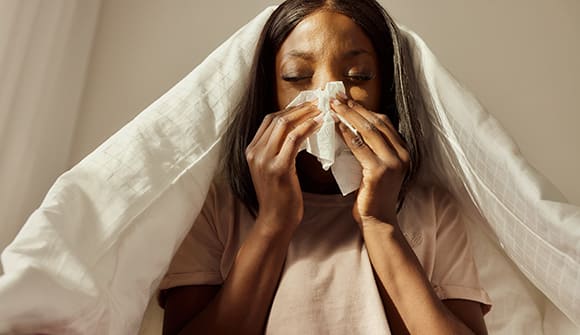Nasty norovirus
The stomach bug that’s sweeping parts of the nation.
Article Author: Juliette Allen
Article Date:

You go from feeling fine to attached to the toilet in a matter of hours. Was it something you ate? Or could it be the dreaded “stomach flu”?
Those who have experienced gastroenteritis – inflammation of the stomach and large intestines – know it’s a battle no one wants to fight. And the most common cause of viral gastroenteritis is a formidable foe called norovirus. According to data from the Centers for Disease Control and Prevention, the GI bug is on the rise throughout the country, especially in the Northeast.
“It can spread extremely easily, which is why we often hear about large groups of people who get infected,” said Shalika Katugaha, MD, system director of Infectious Diseases for Baptist Health.
Tough to stomach: norovirus symptoms
According to Dr. Katugaha, a person may start feeling sick 12 to 48 hours after they’ve been exposed. The most common symptoms of norovirus are:
- Nausea
- Vomiting
- Diarrhea
People may also experience:
- Abdominal cramps
- Fever
- Headache
- Muscle aches
Though most people recover on their own within three days, Dr. Katugaha said it’s crucial to monitor for signs of dehydration resulting from frequent vomiting and diarrhea.
“You should seek medical attention if the diarrhea doesn’t stop in several days or if you have bloody stools, stomach pain or signs of dehydration,” she said.
Stomach bug hotspots
GI viruses, like norovirus, thrive in closed, crowded areas.
“Gastroenteritis spreads when someone comes in contact with the vomit or feces of an infected person. This could be something as simple as shaking hands with someone who has been sick, touching a contaminated handrail or elevator button, or eating contaminated food.”
Because of the way they’re spread, norovirus and other stomach bugs are commonly found in:
- Schools and childcare centers
- Restaurants and catered events
- Health care facilities
- Cruise ships
“Norovirus causes over 90% of outbreaks of diarrheal illness on cruise ships,” Dr. Katugaha said. “When this happens, it often gets a lot of media attention. Cruise ships, though, account for only a small percentage of all norovirus outbreaks. Close living quarters, shared dining areas and surfaces, and rapid passenger turnover make cruise ships prone to spread of illness and a challenge for disease control.”
Stifle the stomach flu
The highly contagious nature of norovirus makes it difficult to avoid entirely, but there are things you can do to minimize your risk.
- Frequently wash your hands with soap and water for at least 20 seconds. Alcohol-based hand sanitizers aren’t as effective against norovirus.
- Keep your hands away from your mouth.
- Avoid food or water that may be contaminated.
- Wash fruits and vegetables thoroughly before eating.
- Eat only thoroughly cooked seafood.
- Disinfect surfaces that may have been contaminated.
Dr. Katugaha added that if you become sick during a cruise, you should seek help from the ship’s medical center and stay in your cabin for at least 24 hours after the last episode of diarrhea or vomiting. Additionally, you should avoid contact with other people and or items that may be used by others.
If you’re experiencing signs of severe dehydration from norovirus or another illness, go to the nearest Emergency Center immediately. A primary care physician can help guide you through sick season and provide tips and care to keep you well. To find the right provider for you and your family, call 904.202.4YOU (4968) or fill out the appointment request form.
Source: CDC norovirus data



